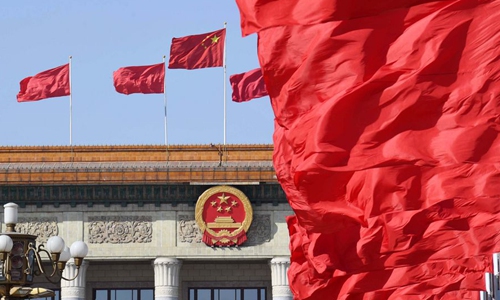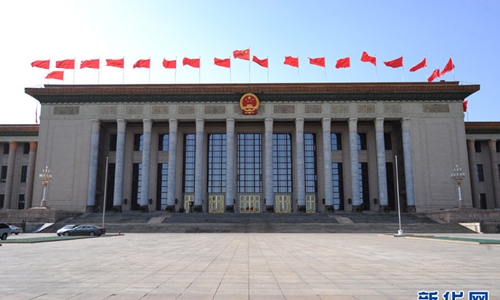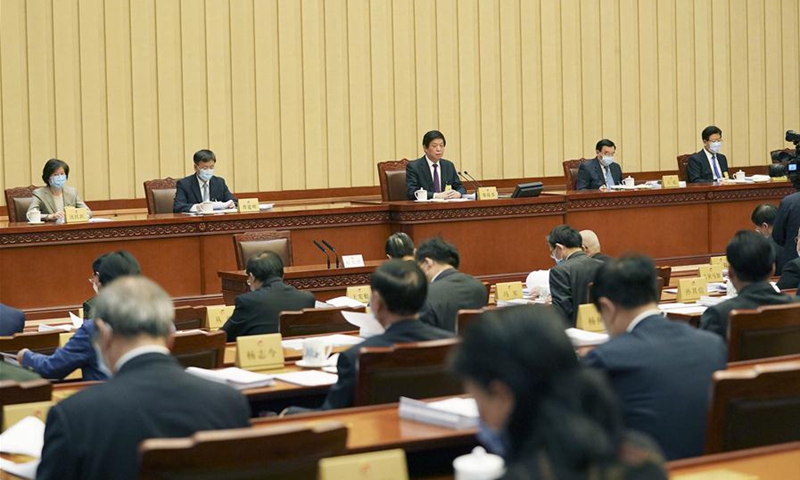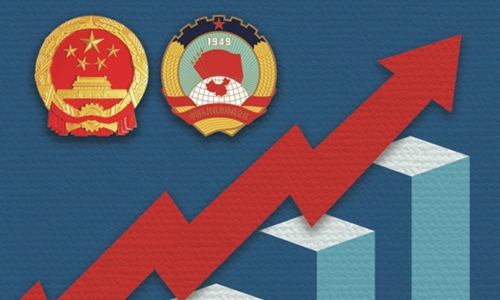
Photo: Xinhua
The annual sessions of China's top legislature and political advisory body, dubbed Lianghui or two sessions, are one of the most important political and economic events in China each year. But this year, with the coronavirus pandemic plunging the world into a crisis, the two sessions carry new meaning, both politically and economically and both domestically and globally.After a roughly two-month delay due to the coronavirus, the plenary session of the National People's Congress (NPC) and the annual session of the National Committee of the Chinese People's Political Consultative Conference (CPPCC) are set to convene on May 22 and May 21, respectively, officials announced on Wednesday.
The immediate and most obvious takeaway from the announcement is that the epidemic has been effectively reined in and the long-term social and economic development agenda is back in play as opposed to the crisis management mode over the past four months.
Some foreign media outlets and even officials often dismiss the two sessions as a "highly choreographed event" that "rubber stamps" government decisions and budget. But for those who watch China closely and more rationally, the occasion provides a valuable window into China's policy agenda and a whole host of issues from government budget to military spending and diplomatic priorities.
The event is particularly significant for foreign economic policymakers, corporate executives and financial traders because the meetings will result in a slew of economic targets and policy priorities in the world's second-largest economy. It will also reveal the hottest business trends and latest technologies in one of the world's largest consumer markets and emerging technological powers. These could affect their business decision-making, especially given the profound uncertainty and tremendous risks in the global economy.
The following is a rundown of what to watch for during the sessions, in terms of economic policy and business trends.
Growth target: a gauge of confidence in China's economy amid the pandemic
For economic reporters, the biggest news from the two sessions is undoubtedly the official target for GDP growth for the year. There have been plenty of rumors about reporters for certain foreign financial news outlets fighting for a copy of the Government Work Report in the hallways of the Great Hall of the People each year.
The lengthy report usually contains China's official GDP growth target for the year. Last year, China for the first time set a target range of 6-6.5 percent growth, amid a persistent slowdown due to industrial transformation and the trade war with the US. China's economy grew by 6.1 percent in 2019, within the target range.
This year, that target might be very different from last year due to the coronavirus pandemic. There have already been various predictions for growth in China. The IMF, in its latest forecast, projected that China's economic growth will slow to 1.2 percent this year and rebound to 9.2 percent in 2021. In the first quarter, China's GDP contracted by 6.8 percent, the first decline in decades as the epidemic saw much of the country shut down.
That and continuing risks from the pandemic in overseas markets have fueled speculation that China might not set a specific target this year. However, Li Daokui, a prominent economist and a member of the CPPCC National Committee, has said that China should set a target to better coordinate economic growth and anti-virus efforts. He suggested that a range of 4-5.6 percent growth, which could translate into 11 million new jobs, could be necessary to maintain social stability.
No matter what comes out of the two sessions in terms of GDP growth target, even if there will be none, it will send a clear signal of where the world's second-largest economy is headed and what lies ahead for the global economy.
Stimulus: coronavirus to replace trade war as the hottest topic
During last year's two sessions, the single biggest topic was the China-US trade war. At the time, the two countries were still in strenuous trade negotiations and exchange of tit-for-tat tariff measures. Trade tensions have significantly eased after the two countries signed a phase one agreement in January, although occasional disputes still exist, mostly coming from the US.
But this year, the coronavirus will most likely dominate discussions during the two sessions, with the thousands of NPC deputies and CPPCC members likely weighing in on epidemic response and economic recovery.
Economically, there are several things to watch for in the discussions of the coronavirus pandemic. The most important one is stimulus. Indeed, the central government and local governments have already taken a series of measures to boost economic activities. However, there are still some on the agenda.
Among others, the budget for the central government and local governments will be reviewed. Specifically, a fiscal deficit target will likely be increased further to cope with the economic fallout of the coronavirus. In 2019, China raised its fiscal deficit target to 2.8 percent of GDP, up 0.2 percentage points from 2018. There are already calls for the country to further raise the deficit to as high as above 4 percent of GDP to boost infrastructure and other sectors.
Another important issue on the agenda of the two sessions is a special government bond expected to exceed one trillion yuan ($141 billion) that will be reviewed by the NPC standing committee. That issuance will not be included in the fiscal deficit.
At last year's two sessions, a hot phrase was "cut taxes and reduce fees." The government work report included a plan to ease the burden on businesses to cut taxes and administrative fees totaling 2 trillion yuan.
As businesses are facing an unprecedented challenge this year due to the coronavirus, there are expectations for a significant expansion in measures to help businesses on top of the measures already in place.
Trending topics: livestreaming, e-commerce, 'new infrastructure'
Each year, new business models and technological innovations get high-profile attention during the two sessions. Last year, topics like 5G, artificial technology (AI), big data and autonomous driving were hot topics among NPC deputies and CPPCC members.
Those topics will likely continue to be popular this year, especially 5G. 2020 has been marked by many as a crucial year for China's deployment of the ultra-fast network, with coverage set to be significant expanded.
At the end of March, there were already more than 31.72 million 5G users in China, up 500 percent from February. This year, China will build more 5G base stations, with the total expected to reach as many as 680,000 by the end of the year.
5G will be included in what has become a common concept since the coronavirus: "new infrastructure." To boost economic growth through investment, officials and experts have determined several areas, including 5G, internet of things, industrial internet, AI, blockchain, big data, smart transportation and others, as top priorities in infrastructure projects.
Local governments have already issued plans to invest a total of 50 trillion yuan in "new infrastructure," according to some forecasts. During the two sessions, there will likely be more measures in this direction.
Another hot topic at this year's two sessions will be the combination of livestreaming and e-commerce - an emerging business model that took off during the coronavirus pandemic. With many shops closed and consumers trapped at home, livestreaming promotions and online shopping became the most efficient way to buy and sell products.
"Livestreaming plus e-commerce" has proven to be especially effective in helping businesses in virus-stricken regions. After central China's Hubei, where the virus first hit, embarked on a recovery, many around the country launched a "buying Hubei" campaign using the model to help boost local businesses in the province.
Seeing the success, some exporters in the country whose businesses have been hit hard by the pandemic overseas have also turned to the model to sell their products in the domestic market.
At the two sessions, which will include officials, business executives, industrial leaders and many others, more endorsements of the model are expected.



